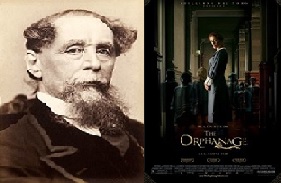Sapna Dogra
Life & Literature

Charles Dickens (Image credit – Wikipedia), Poster of The Orphanage (2007)
Charles Dickens, one of the most celebrated novelists of the 19th century, is known for his realistic portrayal of social issues, dedication to social reforms and for creating characters that have had a long-lasting impact on literature. The predicament of orphans is one of his recurrent themes, and it occupies a notable position in many of his works. Dickens' sympathetic portrayal of orphaned protagonists in a way reflects his own experiences as a child labourer.
Oliver Twist is one of Dickens' most celebrated orphaned characters. Oliver's life starts in a workhouse. It is a place noted for its deplorable living conditions and cruel treatment of its inhabitants. Later, he is thrown into a life of crime and poverty. The corruption Oliver comes into contact with stands in contrast to his innocence. Through Oliver's experiences, Dickens exposes the harsh realities of child exploitation and the dire need for reform.
Dickens introduces Pip in Great Expectations. It is also a story about an orphan who was brought up by his moody sister and her abusive husband, Joe. Things take a turn when Pip receives an unexpected windfall from an unnamed donor. Even though his social status is altered he is unable to shed the weight of his childhood in his social interactions. This draws attention to the long-lasting effects of his orphaned upbringing. Dickens believed that one's past, particularly the experience of being an orphan, influences one's character and destiny, which is reflected in the mystery surrounding his donor and the moral choices he must make.
The most notable antagonists in Dickens' works are also orphans. Fagin and all of the criminals in his gang are orphans. There is a lack of parental love and security in Dicken’s literary world. Search for family and a sense of belonging is a recurring theme. Oliver’s desire to find a loving family and escape the hardships of his orphaned existence is a testament to the innate need for love and security that all children, orphaned or not, share. Oliver's relentless quest for family emphasizes the societal failure to provide emotional and familial support to orphaned children.
It is interesting to note that the horror of an orphan’s existence makes them perfect for the genre of horror films. One of my favourite horror films deals with orphans. The Orphanage (Spanish: "El Orfanato") is a 2007 Spanish horror film directed by J.A. Bayona and produced by Guillermo del Toro. It is a critically acclaimed and influential work in the horror genre. The film is known for its emotional acting, psychological intensity, eerie atmosphere, and emotional connection and depth. It also deals with the ultimate fear of any parent: the loss of one’s child. This makes it a significant film in the horror genre. The film succeeds in creating an excellently haunting and atmospheric setting. The film is set in an ancient and isolated orphanage that is full of dark history and murderous secrets. This setting adds an additional layer of gothic ambience and unease. This becomes a crucial element in building suspense and tension. The old, dilapidated and decrepit building becomes a character in itself, contributing to the film's haunting and uneasy atmosphere. Rather than relying on predictable jump scares or childish violence, the film primarily employs psychological horror. It delves into the psychological state of its characters, especially the protagonist Laura, who is realistically played by Belén Rueda. As a mother, her journey through the mysteries of the orphanage is emotionally harrowing, and the film effectively plays on the fears associated with motherhood, loss, and the fear of the unknown.
One of the film's strengths lies in its ability to successfully blend horror with a deep emotional narrative. There aren’t many horror films that could make its audience cry. Laura's quest to find out the truth about her adopted son's past and the orphanage's history becomes an exploration of grief, incomparable maternal love, and the lengths a parent is willing to go to protect their child. The emotional investment in the characters enhances the audience's connection to the story. The film is also deeply rooted in Spanish culture and folklore, drawing inspiration from folklore, myths and legends. This cultural specificity sets it apart from generic horror films and adds a layer of authenticity to the narrative.
All in all, any work of art, whether a novel or a film, that deals with orphans is also a veiled attempt at what Tim Brayton says about The Orphanage: “musing on parenthood”.
References
Brayton, Tim. “Where do the Children Play.” Alternateending.com. Jan 4, 2008.
https://www.alternateending.com/2008/01/where-do-the-children-play.html

Issue 111 (Sep-Oct 2023)
- Life & Literature: Sapna Dogra
